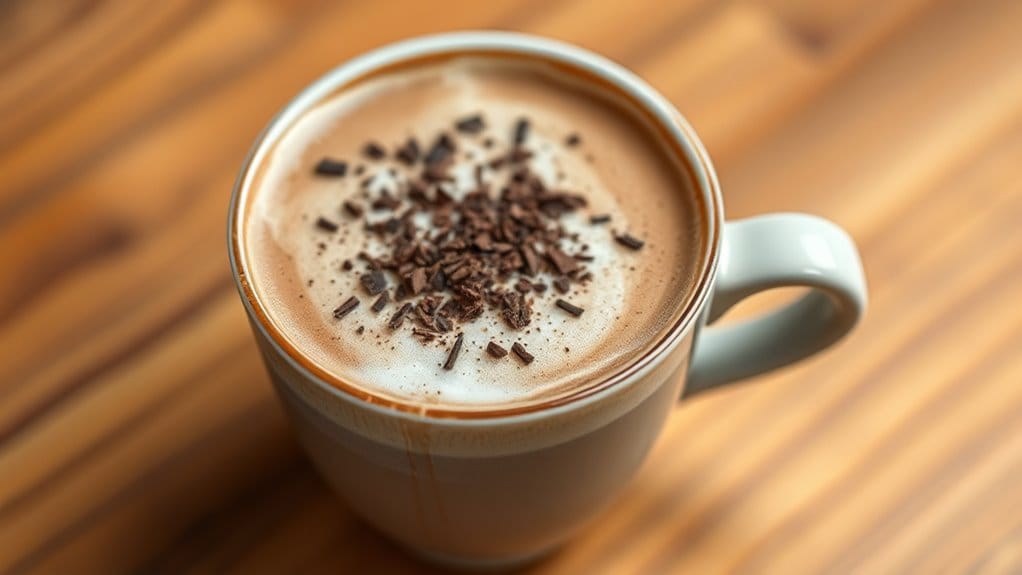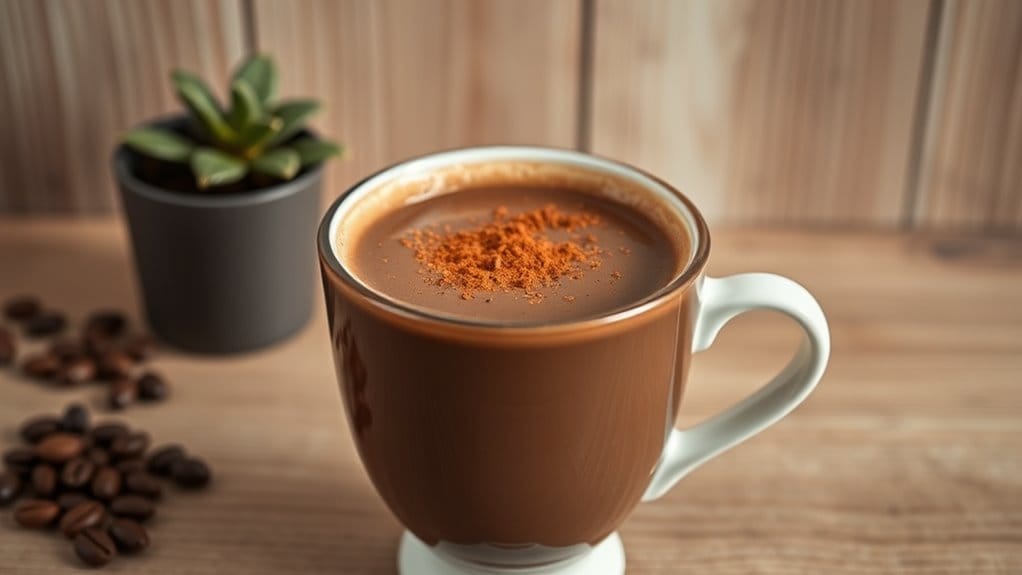A daily mocha might nudge the scale up due to sneaky sugars and creams. Ingredients like chocolate syrup, whole milk, and whipped topping pack 250+ calories—some loaded with 6–20 sugar cubes! But coffee and cocoa bring antioxidants that fight cell damage. To dodge weight gain, swap in unsweetened cocoa, almond milk, or skip whipped cream. Want your mocha to stay tasty without the guilt? Keep scrolling for easy hacks and smart sipping strategies…
What Makes Mocha High in Calories?

Mocha’s calorie count skyrockets from ingredients like chocolate syrup, sugary milk bases, and whipped cream—each pump or dollop adds up!
A typical mocha contains more sugar than a basic coffee, with some versions packing as much sugar as a candy bar, thanks to syrups and milk sugars.
Combine that chocolatey goodness with creamy toppings, and suddenly your drink becomes a dessert posing as a caffeine fix.
Key Calorie Contributors
The sweet temptation of a daily mocha often hides a calorie-packed lineup: chocolate syrup, heaps of added sugar, and creamy whole milk team up to turn this coffee treat into a sneaky weight-gain culprit.
Chocolate syrup alone can add 20 grams of sugar in a single pump, while whipped cream toppings pile on even more fat. Whole milk, though rich and smooth, cranks up saturated fats that linger like uninvited guests.
So, is mocha fattening? When loaded with these extras, absolutely. But mocha benefits shine in moderation: cocoa offers antioxidants, and caffeine enhances focus.
Is mocha healthy? Depends on choices: opt for dark chocolate, skim milk, or smaller sizes. Balance keeps it a joy, not a guilt trip—because nobody wants their drink to outshine dessert!
Sugar Content Analysis
Ever wonder why that cozy mocha feels like sipping dessert?
Mochas pack a sugar punch, blending chocolate, syrups, milk, and toppings into a sweet storm. A medium mocha can deliver 25–84 grams of sugar—that’s like eating 6–20 sugar cubes! For perspective, a medium Mocha Ice Coffee with Cream and Sugar from Dunkin Donuts contains 240 calories—nearly a full meal’s worth for some diets. Yemen has long been known as the global epicenter for coffee cultivation, adding to the rich flavors of mocha. The origin of modern mocha lies in the fusion of coffee and chocolate traditions, highlighting its indulgent nature.
Flavored syrups, stuffed with sucrose or high-fructose corn syrup, dance with natural sugars from milk or cream. Add chocolate sauce or whipped cream, and it’s a sugar rush party. Even “healthier” non-dairy milks often sneak in sweeteners.
Sure, cocoa’s antioxidants might make you wonder: *is mocha good for you?* Maybe, but chugging 84g of sugar (like Café Tango’s jumbo size) daily? Not so much.
Sugar overload spikes calorie intake, fueling weight gain—so order small, skip toppings, or swap syrups to dodge the dessert-in-a-cup trap.
Unexpected Health Benefits of Mocha

While mocha often gets a bad rap for calories, its blend of coffee and cocoa packs a punch of antioxidants, which fight cell damage and lower risks for heart disease or diabetes. Additionally, immersion brewing techniques, like those used in preparing mochas, can contribute to enhancing the flavor of the drink while maximizing nutrient extraction. Interestingly, the caffeine content in mocha can be significant, primarily depending on the number of espresso shots used, with each shot containing around 63-77 mg of caffeine.
It also sneaks in nutrients like magnesium and potassium from cocoa, supporting everything from muscle function to mood balance. Research from *The Annals of Internal Medicine* (2022) reveals moderate coffee consumption correlates with a 30% lower risk of all-cause mortality, suggesting even mocha’s indulgent side might hide life-extending perks.
Even the coffee part brings brain-boosting perks, like sharper focus and protection against memory-robbing diseases, while enhancing physical endurance through caffeine’s adrenaline-boosting effects, making that chocolatey sip more than just a sweet treat.
Antioxidant Properties
Containing mocha’s blend of cocoa and coffee isn’t just a sweet treat—it’s packed with antioxidants, like flavonoids and polyphenols from chocolate, which fight off harmful stuff in the body, sort of like tiny superheroes protecting cells!
These compounds neutralize free radicals, rogue molecules that stress cells, helping ward off long-term issues. Cocoa’s antioxidants enhance blood flow, sharpening focus, while coffee’s caffeine adds its own protective punch.
Imagine them teaming up: chocolate’s flavonoids calm caffeine’s edgy jitters, creating a smoother energy lift. Even better, dark chocolate mochas pack more antioxidant power than milk chocolate versions.
Sure, sugary syrups or whipped cream might dilute the benefits, but the base combo still delivers. So sip that mocha knowing its hidden perks—just don’t let extras turn it into a villain! Additionally, the historical significance of Yemeni coffee contributes to its unique flavor profile, enriching the mocha experience.
Essential Nutrients
Mocha’s antioxidant punch gets attention, but the drink hides other body-enhancing goodies.
Cocoa delivers magnesium for muscle health, iron to fight fatigue, and flavanols that protect blood vessels.
Espresso adds B vitamins for energy production, while milk sneaks in calcium for strong bones.
Even the caffeine teams up, enhancing metabolism and sharpening focus without the jitters cocoa helps mellow.
Surprising bonus? Studies suggest the combo of chocolate and coffee improves attention spans, like a “brain turbocharge” for tackling tasks or cramming for exams.
Sure, added sugars or cream can tip the scales, but a smartly made mocha blends indulgence with perks.
Practical magic: it’s a treat that fuels your body and brain, all while tasting like dessert’s rebellious cousin.
How to Make a Healthier Mocha

Creating a healthier mocha starts with smart swaps, like swapping sugary syrups for cocoa powder, and a simple recipe anyone can follow. Here’s how to enjoy the creamy taste without the guilt:
- Use unsweetened cocoa powder instead of chocolate syrup for rich flavor, minus the sugar rush.
- Opt for low-fat milk or plant-based alternatives to cut calories but keep the frothy texture.
- Skip the whipped cream (yes, even the fluffy kind) to avoid hidden fats and sugars.
- Sweeten with dates or a dash of cinnamon for natural sweetness that doesn’t spike your energy crashes.
| Regular Mocha | Healthier Mocha |
|---|---|
| Chocolate syrup | Unsweetened cocoa powder |
| Full-fat dairy milk | Almond or oat milk |
| Whipped cream topping | Light dusting of cinnamon |
| 3-4 pumps of sugar syrup | 1-2 chopped dates |
| 250+ calories | Under 150 calories |
Building a better mocha takes minutes, uses easy ingredients, and keeps the cozy vibes alive—no math degree required! Additionally, choosing local shops with ethical business practices can enhance your coffee experience while supporting community sustainability.
Smart Ingredient Swaps
While that creamy mocha might taste like dessert in a cup, those sneaky sugars and fats can add up fast, turning your morning treat into a sneaky weight-gain culprit.
Swapping ingredients smartly can keep the flavor while ditching the guilt. Instead of whole milk or cream, try unsweetened almond, oat, or coconut milk for fewer calories and a lighter texture. Many coffee lovers have discovered local coffee shops that offer these alternatives and keep their drinks delicious.
Skip sugary syrups—flavor it with a dash of cinnamon, vanilla extract, or a teaspoon of raw cacao powder for chocolatey depth without the avalanche of sugar.
Opt for dark chocolate (70% or higher) over milk chocolate shavings—it’s lower in sugar, higher in antioxidants.
Replace whipped cream with a sprinkle of cocoa nibs for crunch, or froth milk for creamy topping without the fat bomb.
Small swaps, big wins! Additionally, consider visiting local coffee houses to explore a variety of healthy options and unique flavors.
Step-by-Step Recipe Guide
Indulging in a velvety mocha doesn’t have to mean a sugar overload or hidden calories—this step-by-step guide breaks down how to make a healthier version that’s bold, creamy, and surprisingly simple.
Start with 1 cup of unsweetened almond milk, heated gently on the stove or in the microwave. Stir in 1 teaspoon of unsweetened cocoa powder, blending until smooth.
Add 1 shot of espresso or ½ cup of strong brewed coffee, mixing well. For sweetness, opt for 1 teaspoon of raw honey or maple syrup instead of refined sugar.
Top with a dollop of lightly whipped coconut cream for richness, and sprinkle cinnamon or dark chocolate shavings for flair.
Skip sugary syrups, control portions, and boom—you’ve got a guilt-free mocha that balances indulgence and smart choices, no barista skills required.
5-Step Plan to Enjoy Mocha Mindfully
Savoring mocha mindfully starts with tracking habits and easing into smarter choices, like swapping giant sugary versions for smaller, simpler sips.
Four easy steps help balance enjoyment and health:
- Log each mocha in a notes app or journal to spot sneaky sugar habits.
- Cut back slowly, like going from daily to three times a week, giving taste buds time to adjust. Consider trying a mocha made with Intelligentsia Coffee’s seasonal blends for a unique taste experience.
- Swap milk chocolate syrup for dark chocolate or unsweetened cocoa powder to slash sugar.
- Pick “mini” mochas with oat or almond milk, because tiny treats can add up to big wins (and fewer tight pants). Additionally, remember that brewing techniques can influence caffeine levels, which may affect your overall consumption.
Tracking Consumption
How can someone enjoy that rich, chocolatey mocha without accidentally trading their jeans size for a caffeine improvement? Start by tracking consumption like a detective hunting clues. Apps, notes, or calendars help spot patterns, like ordering mochas after stressful meetings or pairing them with sugary snacks.
Awareness is key: Log size (small beats large), frequency (three times a week vs. daily), and extras (whipped cream? chocolate drizzle?). Imagine apps as tiny accountability buddies, whispering, “Hey, that’s your third one this week!” without judgment.
Check ingredient lists—some cafes sneak in syrups with more sugar than a candy bar. Track mood or energy spikes, too, linking cravings to habits. Keep it simple: No need for spreadsheets, notepads work, or even a phone photo log.
Gradual Reduction Strategy
Tracking mocha habits helps spot patterns, but what comes next? A gradual reduction strategy balances enjoyment and health goals, letting fans keep sipping without guilt.
Start by mixing decaf into regular mocha—half-caf today, three-quarters decaf next week, easing caffeine and sugar intake slowly. Swap milk chocolate for dark, or use almond milk instead of cream, trimming fat and calories while keeping flavor.
Schedule “mocha-free” days, replacing it with lower-sugar options like a long black or latte, which still satisfy cravings. Shrink the cup size: downgrade from large to medium, then small, teaching taste buds to need less.
Celebrate progress with an occasional full-sugar treat, because saying “never again” tastes worse than a sugar-free syrup mishap.
Frequently Asked Questions
Can Switching to Decaf Reduce Mocha-Related Weight Gain?
Switching to decaf addresses caffeine intake but does not reduce the primary contributors to mocha-related weight gain: added sugars and fats. To mitigate caloric impact, opting for low-sugar, minimal-fat alternatives is more effective.
Does Mocha Contain More Calories Than Regular Coffee Drinks?
Like leaves drifting from a tree, caloric density varies widely. Mocha often packs more calories (248–417kj) than bases like long black (8kj) or espresso (40kj), fueled by added sugars and fats typical in indulgent coffee creations.
How Do Sweeteners in Mocha Impact Metabolism?
Sweeteners in mochas, particularly added sugars, increase caloric intake and may spike blood glucose, stimulating insulin release that promotes fat storage. Regular consumption can alter metabolic processes, potentially reducing efficiency in energy utilization over time.
Can Drinking Mocha Before Workouts Affect Fat Burning?
Mocha contains caffeine, which may boost workout energy and alertness, but its added sugars and fats could prioritize carbohydrate metabolism over fat oxidation. Caloric surplus from frequent consumption might hinder net fat loss.
Are Plant-Based Milk Mochas Lower in Calories?
Plant-based milk mochas often have fewer calories than dairy-based versions, depending on milk type and added sugars. Unsweetened almond or oat milk options may reduce calorie intake, while sweetened varieties can negate this benefit.
References
- https://www.mynetdiary.com/food/calories-in-mocha-by-cafe-tango-ml-46188476-0.html
- https://www.mynetdiary.com/food/calories-in-medium-mocha-ice-coffee-with-cream-and-sugar-by-dunkin-donuts-serving-22886293-0.html
- https://www.nutritionvalue.org/Coffee
- https://www.starbucks.com/menu/product/408/hot/nutrition
- https://zarconecocoa.com/blogs/health/health-benefits-of-mochas
- https://www.rush.edu/news/health-benefits-coffee
- https://www.healthline.com/nutrition/top-evidence-based-health-benefits-of-coffee
- https://www.impulsecoffees.com/blogs/all-coffee-blogs/mocha-coffee-benefits-origins-and-types
- https://www.vice.com/en/article/new-study-claims-drinking-mocha-lattes-improves-attention-span/





